

Restaurants play a large role in making client’s eating pattern ’greener’ Comment s’y retrouver dans la jungle des labels environnementaux. Consommer « autrement », oui, mais comment ?
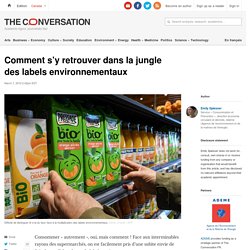
Alimentation durable: un autre sujet de discorde? Agir sur l’alimentation pour sauver le climat ? Décrytage. En ce début d’année 2019, une nouvelle étude vient de sortir sur le poids que représente notre alimentation en matière d’impact sur le climat.

L’Empreinte énergétique et carbone de l’alimentation en France – de la production à la consommation a été publiée en janvier 2019 (1). Searching for a Measure Integrating Sustainable and Healthy Eating Behaviors. A ‘Natural’ Rise in Sustainability Around the World. When it comes to purchase behavior, it’s become abundantly clear that consumers care.

In fact, the majority (73%) of global consumers say they would definitely or probably change their consumption habits to reduce their impact on the environment. As consumers become increasingly aware of what they put in and on their bodies, they’re also interested in buying—and sometimes paying more—for products that simultaneously help the environment.
In fact, almost half (41%) of consumers from around the world say that they’re highly willing to pay more for products that contain all-natural or organic ingredients. Chocolat : mensonges sous emballages. La pêche durable absente des étals français. "La grande distribution n’a aucune politique d’approvisionnement durable pour les trois espèces étudiées (la sole, le bar et le cabillaud)".

Le verdict de l'UFC Que Choisir est sévère. Et pour cause: 86% des poissons en étal ne respectent pas les principes de la pêche durable, démontre l'enquête menée par l'association de consommateurs auprès des poissonneries de plus de 1000 grands supermarchés français. mauvais étiquetage Pire, près de 3 produits sur 4 sont mal étiquetés et induisent le consommateur en erreur. Toute la chaîne alimentaire mondiale pèse pour un tiers des émissions de CO2.
Une pizza faite maison, achetée surgelée ou consommée au restaurant n’aura pas la même saveur. Pour une consommation durable en phase avec les enjeux européens - Rapports publics. Recommandations - 50 mesures pour la durabilité I.
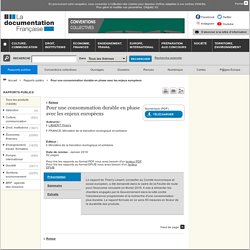
The Spanish Dietary Guidelines: A potential tool to reduce greenhouse gas emissions of current dietary patterns. Consumer behaviour types in household food waste. Which Plant-Based Milk is Best for the Environment? Potential Changes in Greenhouse Gas Emissions from Refrigerated Supply Chain Introduction in a Developing Food System - Environmental Science & Technology.
Empreinte Carbone Alimentation France VF. Ferme France dévoile son étiquette de performance sociétale. Sur la base d’un référentiel de notation, l’association Ferme France présente la première étiquette collaborative d’évaluation de la performance sociétale des produits issus de la production agrico...
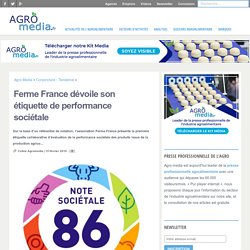
Sur la base d’un référentiel de notation, l’association Ferme France présente la première étiquette collaborative d’évaluation de la performance sociétale des produits issus de la production agricole. Ferme France souhaite ainsi revaloriser le modèle alimentaire français autour d’un référentiel de notation des produits prenant en compte les enjeux sociétaux, environnementaux et les nouvelles attentes des consommateurs. Cette étiquette sociétale est l’aboutissement d’un travail de réflexion collective entre tous les acteurs engagés dans la démarche. Les consommateurs pourront retrouver l’étiquette avant fin 2019 en magasin sur 4 produits emblématiques : le lait, le porc, le poulet et le pain.
Vers une alimentation bas carbone, saine et abordable. Volet 2 – Prospective des régimes alimentaires et évolution de l'empreinte carbone de l'alimentation en France. Health and nutritional aspects of sustainable diet strategies and their association with environmental impacts: a global modelling analysis with country-level detail - The Lancet Planetary Health. L'alimentation durable, un concept encore flou pour le convive de restauration d'entreprise - Restauration21. Carole Galissant (Sodexo) et Gervaise Debucquet (Audencia).
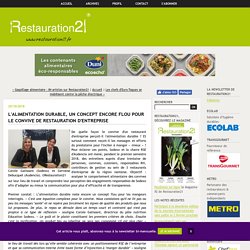
Environmental sustainability of fruit and vegetable production supply chains in the face of climate change: A review. Options for keeping the food system within environmental limits. Decreases in global beer supply due to extreme drought and heat. Household Preferences to Reduce Their Greenhouse Gas Footprint: A Comparative Study from Four European Cities. Ces cinq aliments, symboles de notre mode de vie, sont menacés par le réchauffement climatique. 90 % de la production de café détruite en 2050 Boire une tasse de café le matin va devenir un luxe.

Selon une étude publiée dans la revue PNAS en 2017, la production mondiale de café pourrait diminuer de 90 % d’ici 2050. Ce scénario, le plus pessimiste de l’étude, est la conséquence directe du réchauffement climatique. "Le café est très sensible aux légères variations de température. À mesure que la température montera, tous les pays seront affectés", prévenait d’ailleurs le directeur exécutif de l’Organisation internationale du café (OIC), José Sette lors du premier forum mondial des producteurs de café, organisé en juillet 2017 en Colombie.
Fish in Climate-Friendly and Healthy Diets. Coca-Cola, PepsiCo et Nestlé sont les plus gros pollueurs plastiques du monde selon Greenpeace. Étude sur la durabilité de la filière du café. En octobre ont été publiés les résultats d'une étude du Basic, consacrée à la filière du café.
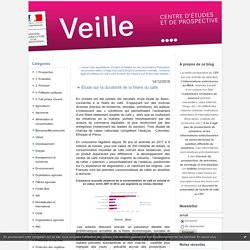
S'appuyant sur des sources diverses (travaux de recherche, données, entretiens), les auteurs s'intéressent aux « conditions qui permettraient l'avènement d'une filière réellement durable du café », alors que se multiplient les initiatives en la matière, portées historiquement par les acteurs du commerce équitable, et plus récemment par des entreprises (notamment les leaders du secteur). Trois études de chaînes de valeur nationales complètent l'analyse : Colombie, Éthiopie et Pérou.
Croissance annuelle moyenne de la consommation de café en volume et en valeur, entre 2007 et 2012, par segments au niveau mondial Source : Basic Comparaison des coûts sociétaux dans les filières Éthiopie-France. BASIC Filiere Cafe Rapport de Recherche Final Septembre 2018 basse résolution. Sustainability of Italian families' food practices: Mediterranean diet adherence combined with organic and local food consumption. 1.
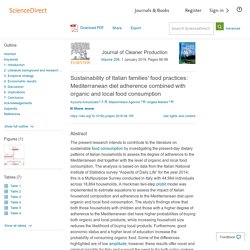
Introduction Sustainable consumption is growing in importance on the international agenda, as confirmed by Agenda 2030 (goal 12), and food consumption is recognized as a major sustainability issue due to its impact on individual and public health, natural resources, social cohesion and the economy (De Boer et al., 2007, Thøgersen, 2017).
The Food and Agriculture Organization of the United Nations (FAO) defines sustainable diets as those “with low environmental impacts which contribute to food and nutrition security and to healthy life for present and future generations. They are protective and respectful of biodiversity and ecosystems, culturally acceptable, accessible, economically fair and affordable; nutritionally adequate, safe and healthy, while optimizing natural and human resources” (FAO, 2012, p.7). 2. Attentive, speculative experimental research for sustainability transitions: An exploration in sustainable eating. Aan et al., 2013 A. Aan, L. Laumets, E. -L. Orula, P.
Breaking away from industrial food and farming systems. Seven case of agroecological transition. The role of trade in the greenhouse gas footprints of EU diets. Arima et al., 2011 E.Y. Arima, P. Richards, R. Walker, M.M. CaldasStatistical confirmation of indirect land use change in the Brazilian Amazon Environ. Aston et al., 2012 L.M. Measuring what works: quantifying greenhouse gas emission reductions of behavioural interventions to reduce driving, meat consumption, and household energy use.
How much fish do we consume? First global seafood consumption footprint published. JRC scientists have examined the impact of seafood supply chains across national boundaries - the global seafood consumption footprint. Global seafood consumption has more than doubled in the past 50 years, putting stress on the sustainability of fishingNet importing nations must consider the sustainability of their trading partners' fishing practices, not just their domestic onesNew analysis on international supply chains makes the case for international collaboration on long-term sustainability of all seafood production Taking into consideration both food that humans consume and seafood processed for feed production, seafood consumption in EU member states equals 27 kg per head.
The highest consumption at EU level is observed in Portugal (61.5 kg per head) while outside the EU, the top consumers are Korea (78.5 kg per head) followed by Norway (66.6 kg per head). The global per head consumption is estimated at 22.3 kg. Global demand for seafood is growing. Growing the Good. The Case for Low-Carbon Transition in the Food SectorGrowing the Good report v3.
What Lies Behind the Transition From Plant-based to Animal Protein. Linking sustainability to the healthy eating patterns of the Dietary Guidelines for Americans: a modelling study. Introduction Human health, environmental sustainability, and food security are linked in complex and multidirectional ways. One important intersection occurs between food production and the natural environment. At present, agriculture is the largest consumer of fresh water and the second largest contributor to anthropogenic greenhouse gas emissions worldwide (including land use change).1, 2 Agriculture is also the driving force behind the disruption of global nitrogen and phosphorus cycles, with particular burden coming from increases in the quantity and intensity of livestock production.3 Planetary boundaries for biogeochemical flows (of nitrogen and phosphorus) and climate change are estimated to already be exceeded.4 Disrupted planetary systems produce effects that will continue to feed back into agricultural and food systems if left unchanged.
Research in context Evidence before this study. The environmental impact of packaging in food supply chains—does life cycle assessment of food provide the full picture? Impact de notre consommation sur l’environnement, une vaste étude fait le point. Les Français consomment depuis 50 ans davantage de biens chaque année. Sustainable food systems—a health perspective. Positive dietary shifts Growing evidence suggest that population-level dietary changes could improve both health and environmental sustainability (Aleksandrowicz et al. 2016; Nelson et al. 2016; Perignon et al. 2017). Thus, a transition to diets that follow consensus national dietary guidelines could substantially reduce the environmental impacts of food systems and improve population health outcomes (Behrens et al. 2017).
Animal source foods are high in saturated fats and usually incur higher environmental burdens than plant-based diets, mainly due to larger need of land and to the energy and material inputs required for feed and methane produced from enteric fermentation; the latter specifically of ruminants (Herrero et al. 2013). Thus, switching to healthy plant-based diets with lower animal source food content could reduce GHG emissions and free land, whilst also having co-benefits for health, in particular reductions in non-communicable disease risk (Tilman et al. 2011). Sustainable Consumption in Everyday Life: A Qualitative Study of UK Consumer Experiences of Meat Reduction.
Carbon footprint and nutritional quality of different human dietary choices. Apart from industrial activities, our eating habits also have a significant environmental cost associated with crop cultivation, manufacturing processes, packaging, refrigeration, transport cooking and waste management. In a context of growing social awareness of the role of different dietary choices in the environment, the review of different alternatives on the road to a healthy and sustainable diet should integrate relevant information on the nutritional quality of different eating habits.
Since dietary choices have an effect on environmental sustainability and human health, a literature review on different dietary choices has been conducted to determine the differences in carbon footprint and nutritional quality identifying the main hotspots trying to give advice towards the identification of sustainable diets. After applying a set of criteria for reference selection, 21 peer-reviewed studies have been analysed in detail, allowing the comparison of 66 dietary scenarios.
The water footprint of different diets within European sub-national geographical entities. Impact of anthropogenic CO 2 emissions on global human nutrition. 1. Le Quéré, C., Andrew, R. Emissions impossible EN 12 page. The Final Countdown: Now or never to reform the palm oil industry - Greenpeace International. A Greenpeace investigation has exposed how the world’s biggest brands are still linked to rainforest destruction in Indonesia.
Palm oil suppliers to the world’s largest brands, including Unilever, Nestlé, Colgate-Palmolive and Mondelez, have destroyed an area of rainforest almost twice the size of Singapore in less than three years, according to the report. Greenpeace International assessed deforestation by 25 major palm oil producers and found that: 25 palm oil groups had cleared over 130,000ha of rainforest since the end of 201540% of deforestation (51,600ha) was in Papua, Indonesia – one of the most biodiverse regions on earth and until recently untouched by the palm oil industry 12 brands were sourcing from at least 20 of the palm oil groups: Colgate-Palmolive, General Mills, Hershey, Kellogg’s, Kraft Heinz, L’Oreal, Mars, Mondelez, Nestlé, PepsiCo, Reckitt Benckiser and UnileverWilmar, the world’s largest palm oil trader, was buying from 18 of the palm oil groups.
Climate impact of alcohol consumption in Sweden. The figure below shows the emissions from the different supply chain stages of each alcohol type. Strong wine has a greater carbon footprint from packaging because it tends to be packed in glass bottles, whereas regular wine is frequently packaged in cartons or a “bag in a box”. The industrial stage is particularly high for liquor because of the distillation step. Image: Figure 1, Hallström et al.
Average total climate impact per litre alcoholic beverage produced and GHG emissions produced in different stages of the production chain. Results are presented as weighted averages representative for alcoholic beverages consumed in Sweden. Current global food production is sufficient to meet human nutritional needs in 2050 provided there is radical societal adaptation. Théma L'action citoyenne 0. Understanding Food and Climate Change. Food in a warming world report. La pollution à l’ozone menace aussi nos assiettes. « Manger vers le futur », la BD numérique qui pense l’alimentation durable de demain. G04300 - Citizen-generated evidence for a more sustainable and healthy food system - pubs.iied.org. Sustainable diets: are nutritional objectives and low-carbon-emission objectives compatible? Environmental Impacts of Plant-Based Diets: How Does Organic Food Consumption Contribute to Environmental Sustainability?
A Comprehensive Life Cycle Assessment of Greenhouse Gas Emissions from U.S. Household Food Choices. Unsustainable dietary habits of specific subgroups require dedicated transition strategies: Evidence from the Netherlands. Food Climate Research Network (FCRN) Using dietary quality scores to assess sustainability of food products and human diets: A systematic review. Better meat report FINAL.
Evolución Comercio Online en Alimentación - España. Produire et s'alimenter responsable à Paris. Analyse des effets économiques et sociaux d'une alimentation plus durable. Etude-lalimentationdurable-creatrice-de-valeur-au-long-de-la-chaine-des-acteurs. Simulating the Impact of Carbon Taxes on Greenhouse Gas Emission and Nutrition in the UK. Measures and metrics of sustainable diets with a focus on milk, yogurt, and dairy products.
Réchauffement climatique : Mars mise sur du chocolat génétiquement modifié pour sauver son business model. [LE CHIFFRE] Des burgers bœuf-champignons permettraient d’éviter l’équivalent des émissions de CO2 de 2,3 millions de voitures par an. Environmental Impacts of Plant-Based Diets: How Does Organic Food Consumption Contribute to Environmental Sustainability? Quiz : connaissez-vous l'impact de l'alimentation sur la biodiversité ? Swiss chocolate industry pledges 80% sustainable cocoa by 2025. Food Climate Research Network (FCRN) Food Climate Research Network (FCRN) Food Climate Research Network (FCRN) Reducing GHG emissions while improving diet quality: exploring the potential of reduced meat, cheese and alcoholic and soft drinks consumption at specific moments during the day.
Eating for 2 degrees Full Report. Politicians need to push plant-based diets, say Swedish researchers. Eating better report: The future of eating is flexitarian. Could consumption of insects, cultured meat or imitation meat reduce global agricultural land use? European Public Health Association report: Healthy and Sustainable Diets for European Countries. Viande et stratégies d'alimentation durable et moins productrice de gaz à effets de serre - CIV - Viande, Sciences et Société. How Do Dietary Choices Influence the Energy-System Cost of Stabilizing the Climate? Shrinking the Carbon and Water Footprint of School Food: A Recipe for Combatting Climate Change. Redefining Protein: Adjusting Diets to Protect Public Health and Conserve Resources. Less beef, less carbon: Americans shrink their diet-related carbon footprint.
Grabbing the bull by the horns: it’s time to cut industrial meat and dairy to save the climate. Effects of climate change would encourage most British adults to change their diet. A healthier US diet could reduce greenhouse gas emissions from both the food and health care systems. Potentiels d'expansion de la consommation collaborative pour réduire les impa... Alimentation durable : la France bonne élève du G20.
Carbon price would result in food costs rising 3% Cerin – Cholé-doc : « Quelle compatibilité entre qualités nutritionnelle et environnementale de l’alimentation en France ? » Index aiming to reflect both climate impact and nutritional impact of food products. Public Health England’s guide to their approach on creating the 2016 Eatwell Guide. Global Analysis of the Effects of a GHG Food Tax on GHG Emissions and Human Health. German Environment Agency: ‘Tax animal products to tackle climate change’ – EurActiv.com. Beyond calorie counting: assessing the sustainability of food provided for public consumption.
Triming the excess: environmental impacts of discretionary food consumption in Australia. Mon Restau Responsable®, en route vers des cantines plus durables.